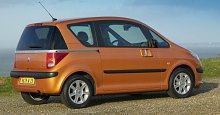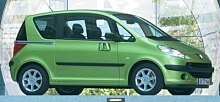|
 We
loved the outgoing Peugeot 106 very much. It was small and light,
accelerated briskly and cornered handsomely. When it passed away,
Peugeot replaced it with not one but 2 models - the 107 is actually a
Toyota-engineered mini car targeting at an even lower price segment
than 106. With sales target of only 100,000 units a year, it is
obviously not the focus of Peugeot. Instead, the limelight falls on
1007. The one-double-o-seven not only breaks the mould of Peugeot's
3-digit naming system, it is also a revolutionary design, claimed the
French company. We
loved the outgoing Peugeot 106 very much. It was small and light,
accelerated briskly and cornered handsomely. When it passed away,
Peugeot replaced it with not one but 2 models - the 107 is actually a
Toyota-engineered mini car targeting at an even lower price segment
than 106. With sales target of only 100,000 units a year, it is
obviously not the focus of Peugeot. Instead, the limelight falls on
1007. The one-double-o-seven not only breaks the mould of Peugeot's
3-digit naming system, it is also a revolutionary design, claimed the
French company.
What is so revolutionary? a few years ago, Pininfarina came up an idea
to solve the increasingly critical parking problem in overcrowded
cities. Mini cars are more friendly to tight parking space, but when
the doors are opened for passenger access, they still require
considerable width. That's why Pininfarina designed a mini car with an
electric sliding door at each side. By touching a button, the big door
can slide back and reveal a big aperture for both front and rear
passengers to get off. It engages no more width than the mirror already
take, thus the car can slip into very tight parking space. This car
became Peugeot 1007 eventually.
 Disappointingly,
today Pininfarina is no longer capable of designing beautiful cars - do
you remember the 406 Coupe ? or the earlier 205 and 405 ? it is really
unbelievable the same design house of these beautiful cars can give us
a car like 1007 - it has wrong proportion and poor details. In short,
it looks odd. Yes, its shape might be driven primarily by functions,
but still it could be prettier, couldn't it? Disappointingly,
today Pininfarina is no longer capable of designing beautiful cars - do
you remember the 406 Coupe ? or the earlier 205 and 405 ? it is really
unbelievable the same design house of these beautiful cars can give us
a car like 1007 - it has wrong proportion and poor details. In short,
it looks odd. Yes, its shape might be driven primarily by functions,
but still it could be prettier, couldn't it?
Despite of the unusual form, the underpinning of 1007 comes directly
from Citroen C2 / C3. This is a frill-free (and thrill-free) platform
using strut and torsion-beam suspensions, electric power steering and
the familiar powertrains from PSA's part pool. From mechanical point of
view it is absolutely boring. However, it saves money for PSA and saves
my time.
From the photos, you can see 1007 is very tall - at 1.62 meter, its
roof is higher than the eye level of some drivers. The question is who
need so much headroom. There is no such thing as "too much headroom",
as long as it does not compromise other things. However, experience
tell us there is no free lunch in the world. The 1007 pays the price in
dynamics. It is almost 200 kg heavier than 206 (partly blame to the
added weight of electric doors), blunting its acceleration. It has
higher center of gravity than regular mini cars, generating more body
roll in cornering thus leads to incapable handling. Also, don't expect
a smooth ride normally associated with Peugeot's cars, because that
would have required a suspension setup so soft that cannot handle its
excessive height.
 The
point is: Peugeot 1007 is by no means a driver's car. It is a more a
housewife car, a car to take the kids to school and to shop a whole
weekend's food at supermarket. Its 4-seat cabin accommodates people
comfortably when the rear seats slide to the rearmost position, or
carry a lot of luggage when it slide forth or simply flip up. It is
basically a mini MPV. The
point is: Peugeot 1007 is by no means a driver's car. It is a more a
housewife car, a car to take the kids to school and to shop a whole
weekend's food at supermarket. Its 4-seat cabin accommodates people
comfortably when the rear seats slide to the rearmost position, or
carry a lot of luggage when it slide forth or simply flip up. It is
basically a mini MPV.
But when it is seen as a mini MPV, what is so revolutionary then? the
American put power sliding doors at their big MPVs many years ago.
Peugeot / Pininfarina just copied the idea to mini cars. It is nothing
worth amazing or praising, especially if you learn the drawbacks it
created. |